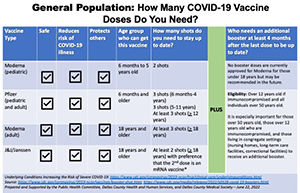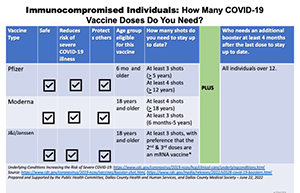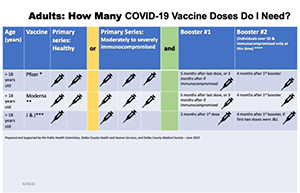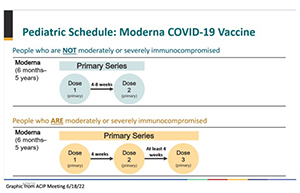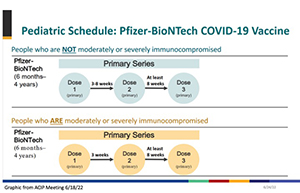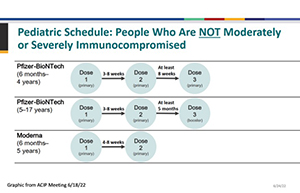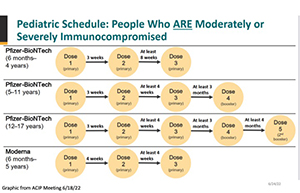Coronavirus (COVID-19)
Health and Safety Guidance
Health Guidance for the Public
Over the past two years, the COVID-19 pandemic has been dynamic and rapidly changing and has required ongoing updates to our recommendations. Since inception, our goal has been to provide Dallas County residents with helpful guidance based on science. This is a “living” document and we will continue to update it as the data and scientific understanding dictate.
Orientación de salud para el público
En los últimos dos años, la pandemia de COVID-19 ha sido dinámica y ha cambiado rápidamente y ha requerido actualizaciones continuas de nuestras recomendaciones. Desde el inicio, nuestro objetivo ha sido brindar a los residentes del condado de Dallas una guía útil basada en la ciencia. Este es un documento "vivo" y continuaremos actualizándolo según lo dicten los datos y la comprensión científica.
How Many Covid-19 Doses Do I Need?
Click the images below to view a larger version or scroll through as a slideshow.
Click on a question below to view the answer.
CDC: “When Are You Up to Date?”
- You are up to date with your COVID-19 vaccines when you have received all doses in the primary series and all boosters recommended for you, when eligible.
- Vaccine recommendations are different depending on your age, the vaccine you first received, and time since last dose, as shown below. Learn more about COVID-19 vaccine recommendations specifically for people who are moderately or severely immunocompromised.”
- More from the CDC on staying up to date: https://www.cdc.gov/coronavirus/2019-ncov/vaccines/stay-up-to-date.html
* Doses in primary series:
- healthy: 3 weeks apart among 5-11 year olds and 3-8 weeks apart those over 12 years and older; under 5 years old may have an extended dosing schedule based on vaccine type,
- immunocompromised: 3 weeks apart in 5-11 year olds with 3rd dose 4 weeks after 2nd dose
** Doses in primary series: 4-8 weeks apart
*** mRNA vaccine is preferred over J&J for second and booster vaccine doses
**** It is especially important for the following to receive the second booster: all individuals over 50, individuals over 12 who are immunocompromised, and all individuals who qualify and live in a congregate care setting (long term care facilities, nursing homes, correctional facilities etc.)
**** Underlying Conditions Increasing the Risk of Severe COVID-19: https://www.cdc.gov/coronavirus/2019-ncov/hcp/clinical-care/underlyingconditions.html
Source: https://www.cdc.gov/coronavirus/2019-ncov/vaccines/booster-shot.html, https://www.cdc.gov/media/releases/2022/s0328-covid-19-boosters.html
Vaccine and booster recommendations may be updated as CDC acquires new data, including how well the vaccines work over time and against new variants.
What is the Definitions for Immunocompromised Person (Ages 5 Years and Older [> 5])
- Individuals who have or are
- moderate or severe primary immunodeficiency (e.g., DiGeorge syndrome, Wiskott-Aldrich syndrome) OR
- advanced or untreated HIV infection OR
- Solid organ; bone marrow transplant or chimeric antigen receptor (CAR)-T-cell or hematopoietic stem cell transplant (within 2 years of transplantation or taking immunosuppression therapy) OR
- receiving treatment for solid tumor and hematologic malignancies OR with high-dose corticosteroids (i.e., ≥ 20 mg prednisone or equivalent per day when administered for ≥ 2 weeks), alkylating agents, antimetabolites, transplant-related immunosuppressive drugs, cancer chemotherapeutic agents classified as severely immunosuppressive, tumor-necrosis factor (TNF) blockers, and other biologic agents that are immunosuppressive or immunomodulatory OR
- taking other immunosuppressive therapy.
Source: https://www.cdc.gov/coronavirus/2019-ncov/vaccines/recommendations/immuno.html#mod
Employer/Employee Guidance
Strong scientific evidence indicates that COVID-19, including the Delta variant, is spread almost entirely by virus-containing droplets and aerosols that infected people project into the air by breathing, talking, laughing, yelling, coughing, or sneezing; whereas spread by contamination on surfaces is of secondary importance. Therefore, to prevent the spread of COVID-19 from your business, the most important measures are those that prevent person-to-person transmission by infected people from spreading it.
Orientación Para El Empleador/Empleado
Fuerte evidencia científica indica que COVID-19, incluida la variante Delta, se transmite casi en su totalidad por gotitas y aerosoles que contienen virus que las personas infectadas proyectan al aire al respirar, hablar, reír, gritar, toser o estornudar; mientras que la propagación por contaminación en las superficies tiene una importancia secundaria. Por lo tanto, para evitar la propagación de COVID-19 desde su negocio, las medidas más importantes son aquellas que evitan que la transmisión de persona a persona por parte de personas infectadas la propague.
Today's Risk Level
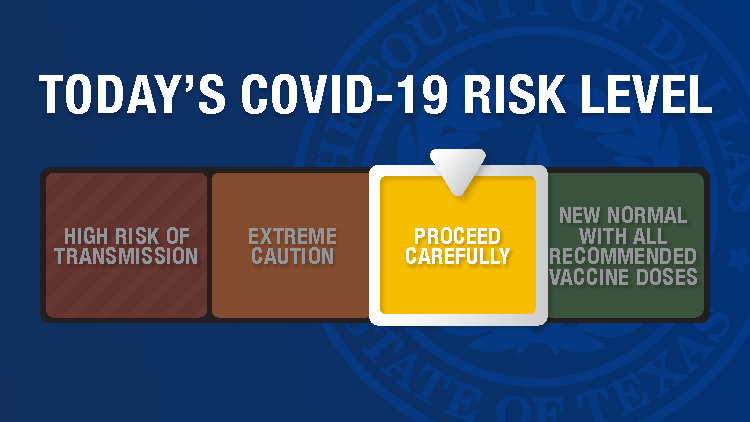
Nivel Actual de Riesgo
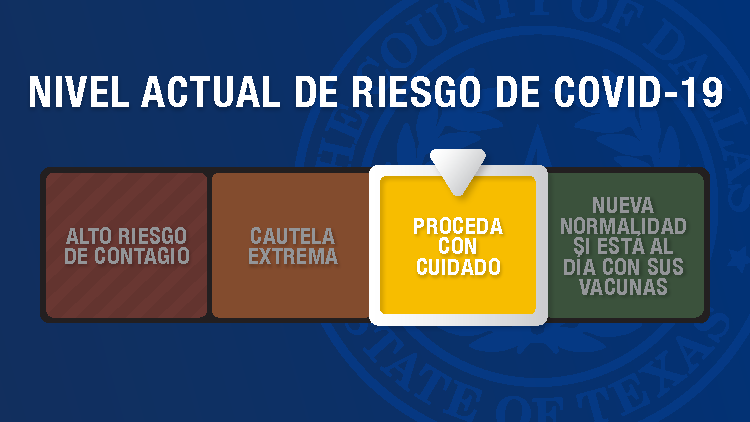
Dallas County Key COVID-19 Response Metrics/Indicators
The updated Dallas Country metrics/ indicators are based on new knowledge and information that continues to emerge and enhance our understanding of how to assess the Dallas County COVID-19 response. These metrics/indicators are based on information from Resolve to Save Lives, COVID Local, their collaborators, and numerous other sources and will provide the framework for determining how and when to relax or strengthen activities and interventions. Essentially, they will help assess the effectiveness of the Dallas County COVID-19 Response. The Public Health Committee utilizes the metrics/ indicators to assist in determining the risk of COVID-19 transmission within the county. Each set of metrics/indicators builds on prior core metrics and continues to use the Dallas County “stoplight” guidance system which includes four phases/levels of COVID-19 transmission risk: RED, ORANGE, YELLOW, and GREEN.
Métricas/Indicadores Clave de Respuesta al COVID-19 del Condado de Dallas
Las métricas / indicadores actualizados del condado de Dallas se basan en nuevos conocimientos e información que continúan surgiendo y mejoran nuestra comprensión de cómo evaluar la respuesta al COVID-19 del condado de Dallas. Estas métricas/ indicadores se basan en información de Resolve to Save Lives, COVID Local, sus colaboradores y muchas otras fuentes y proporcionarán el marco para determinar cómo y cuándo relajar o fortalecer las actividades e intervenciones. Esencialmente, ayudarán a evaluar la efectividad de la respuesta al COVID-19 del condado de Dallas. El Comité de Salud Pública utilizará las métricas/ indicadores para ayudar a determinar el riesgo de transmisión de COVID-19 dentro del condado. Cada conjunto de métricas/ indicadores se basa en métricas básicas anteriores y continúa utilizando el sistema de orientación de “semáforo” del condado de Dallas, que incluye cuatro fases/ niveles de riesgo de transmisión de COVID-19: ROJO, NARANJA, AMARILLO, y VERDE.
Masking Best Practices
Masks are key to preventing transmission of SARS CoV 2, the virus that causes COVID 19. Masks should be used as critical part of a comprehensive ‘Do it approach including but not limited to physical distancing, avoiding crowded, closed and close contact settings, good ventilation, cleaning hands, and covering sneezes and coughs. Masks are not a substitute for physical distancing.
Mejores Prácticas de Enmascaramiento
Las máscaras son clave para prevenir la transmisión del SARS-CoV-2, el virus que causa el COVID-19. Las máscaras deben usarse como una parte fundamental de un enfoque integral de "¡Házlo todo!", que incluye, entre otros, el distanciamiento físico, evitar entornos abarrotados, cerrados y de contacto cercano, buena ventilación, lavarse las manos y cubrirse los estornudos y la tos. Las máscaras no sustituyen al distanciamiento físico.
Additional Guidance
Additional guidance and answers to many questions regarding COVID can be found on the CDC website: Coronavirus Disease 2019 (COVID-19) | CDC.
Orientación Adicional
Puede encontrar orientación adicional y respuestas a muchas preguntas sobre COVID en el sitio web de los CDC: Enfermedad del coronavirus 2019 (COVID-19) | CDC.
Previously Issued Guidance
Click here to view older guidance information.
QUICK LINKS
LOCATIONS
EMPLOYEES
-
You must be on the network to see these links.

